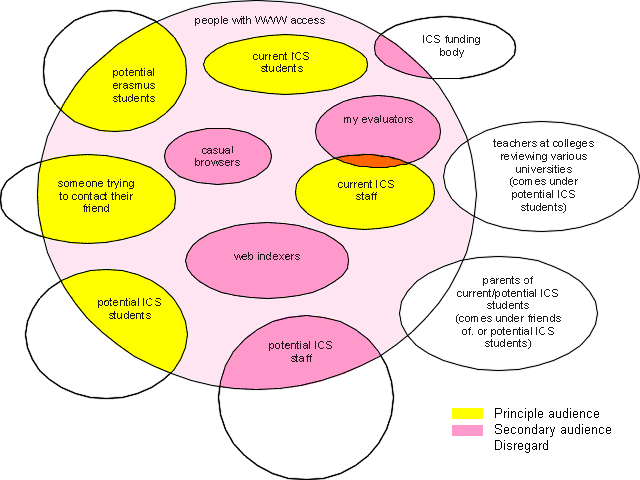Audience Information
As discussed in the development methodology,
this element is concerned with pin-pointing the target audience
as well as considering information about the audience relevant
to the web development.
Cluster Diagram
To establish the target audience for the ICS web, I wrote down
every potential user I could think of, and then arranged them
into the following cluster diagram;

I then made use of colour to identify;
- The principle audience. This is the audience the web
is designed specifically for.
- The secondary audience. The web is, in general, not
aimed at these groups, but they must not be forgotten about.
The remaining (unshaded) groups of people, I decided will come
under a different category.
Principle Audience Definition
The principle audience definition (the most popular first) can
therefore be considered to be;
- Current ICS students
- Current ICS staff
- Potential ICS students
- Friends of current personnel
I believe the current ICS students will make most use of the web,
and I have decided to bear this group in mind when designing the
home page.
Audience Characteristics
Much of the information I am giving at this stage may not have
a direct contribution to the design of the web. I still supply
this information, however, to allow reviews of the web to understand
my reasoning about forthcoming elements of the web.
This is a list of characteristics of the audience, relevant to
developing the web.
- Current staff and students ("members")
Are Web literate, well-educated
- Friends of current members
May be web-illiterate, want quick results
- Potential members
May be web-illiterate, want quick results, well-educated
Audience Concerns
This is a list of relevant concerns of the target audience. This
list explores what the audience want with relation to the departmental
web.
- Current ICS members
- Topics concerning the ICS Department
- want to be able to view time-tables for courses
- want to be able to view and/or contribute to a departmental
noticeboard
- may require access to web-based components of modules (i.e.
courses)
- want to be able to view and/or contribute to a departmental
calendar of events
- Access to the Internet
- want to view relevant faq's
- want access to good search engines
- want to learn about WWW authoring
- want to know how to publicise their own web pages
- General Topics
- members want to contact other members
- want to view available modules (courses) to choose from, including
descriptions and may want help choosing them
- want to be able to view/contribute to internal/external news
reports
- want post-graduate job information
- want information about industrial placements
- want information about Erasmus exchanges
- Friends of current members
- want to contact a their friend as quickly and easily as possible
- want to see their friends homepage
- want to email their friend
- want to phone them, write to them etc.
- Potential members
- want to see all degree/module/project possibilities
- want to know about life in Lund or at university
- want to ask questions - to teachers, to current students
- want to know 'how good' Lund University is compared to others
- want to see current and past research
- want to see photographs of the department - inside and out
- want to know "how do I get there?", "how do
I make contact?", "how do I enroll?", "how
do I fund it?"
- want to know who to ask these questions to
Audience Activities
This list explores activities of the target audience which may
give more information about them, or more insight into how the
web can best suit their needs.
- Current members
- teach
- study
- communicate
- attend trade shows, presentations
- use the WWW
- Friends of current members
- may use the WWW
- communicate with current members
- Potential members
- investigate various universities
- may use the WWW
A later addition to the target audience not seen here, are people trying to locate
research projects. This group of people have similar concerns and characteristics
to the "friends of current members". This component of the web will be featured
in subsequent sections.
Thus, I now have a definition of the target audience, as well
as lists of useful information about them. This will contribute
to the next web element, the purpose statement.

